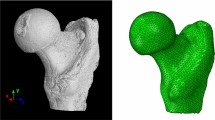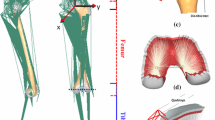Abstract
Load-bearing bones have a capacity to ground the load from the point of impact to the opposite end (distal end) of the same bone irrespective of the direction of (inclination) impact forces. This is only possible due to highly heterogeneous microstructure of bones. In such circumstances, it is unjustified to assume bone to be isotropic in nature. Therefore, a correction factor is introduced while assuming material property of the bone, and thus non-isotropic modeling was considered. In this study, stress analysis of proximal femur bone with isotropic and anisotropic (non-isotropic) material property is modeled while the reaction force corresponding to walking cycle is implemented at the femur head. The results showed a significant variation of 30–45% while evaluating Von-Mises stress and strain developed on the femur bone under different loading conditions. Maximum Von-Mises stress is found on the lateral-interior side of femur, while maximum strain is identified on the same plane near the neck region of femur head. This study concludes the significance of anisotropic modeling of femur bone subjected to variable loading condition.















Similar content being viewed by others
References
Bessho, M., Ohnishi, I., Matsuyama, J., Matsumoto, T., Imai, K., & Nakamura, K. (2007). Prediction of strength and strain of the proximal femur by a CT-based finite element method. Journal of Biomechanics, 40(8), 1745–1753.
Reijman, M., Pols H. A., Bergink, A. P., Hazes J. M., Belo J. N., Lievense A. M., & Bierma-Zeinstra S. M. (2007). Body mass index associated with onset and progression of osteoarthritis of the knee but not of the hip: the Rotterdam Study. Annals of the rheumatic diseases 66(2), 158–162.
Taddei, F., Schileo, E., Helgason, B., Cristofolini, L., & Viceconti, M. (2007). The material mapping strategy influences the accuracy of CT-based finite element models of bones: an evaluation against experimental measurements. Medical Engineering & Physics, 29(9), 973–979.
Trabelsi, N., Yosibash, Z., & Milgrom, C. (2009). Validation of subject-specific automated p-FE analysis of the proximal femur. Journal of Biomechanics, 42(3), 234–241.
Wille, H., Rank, E., & Yosibash, Z. (2012). Prediction of the mechanical response of the femur with uncertain elastic properties. J Biomech [Internet]., 45(7), 1140–1148.
Keyak, J. H., & Falkinstein, Y. (2003). Comparison of in situ and in vitro CT scan-based finite element model predictions of proximal femoral fracture load. Medical Engineering & Physics, 25(9), 781–787.
Lengsfeld, M., Schmitt, J., Alter, P., Kaminsky, J., & Leppek, R. (1998). Comparison of geometry-based and CT voxel-based finite element modelling and experimental validation. Medical Engineering & Physics, 20(7), 515–522.
Peng, L., Bai, J., Zeng, X., & Zhou, Y. (2006). Comparison of isotropic and orthotropic material property assignments on femoral finite element models under two loading conditions. Medical Engineering & Physics, 28(3), 227–233.
Yosibash, Z., Katz, A., & Milgrom, C. (2013). Toward verified and validated FE simulations of a femur with a cemented hip prosthesis. Medical engineering & physics., 35(7), 978–987.
Yosibash, Z., Trabelsi, N., & Milgrom, C. (2007). Reliable simulations of the human proximal femur by high-order finite element analysis validated by experimental observations. Journal of biomechanics, 40(16), 3688–3699.
Gislason MK, Ingvarsson P, Gargiulo P, Yngvason S, Guðmundsdóttir V, Knútsdóttir S, et al. 2014 Finite element modelling of the femur bone of a subject suffering from motor neuron lesion subjected to electrical stimulation. European journal of translational myology, 24(3):187–93.
Crookshank, M., Ploeg, H.-L., Ellis, R., & MacIntyre, N. J. (2014). Repeatable calibration of Hounsfield units to mineral density and effect of scanning medium. Adv Biomech Appl [Internet]., 1(1), 15–22.
Ruess, M., Tal, D., Trabelsi, N., Yosibash, Z., & Rank, E. (2012). The finite cell method for bone simulations: verification and validation. Biomechanics and Modeling in Mechanobiology, 11(3–4), 425–437.
Das, S., & Sarangi, S. K. (2014). Finite element analysis of femur fracture fixation plates. International Journal of Basic and Applied Biology, 1(1), 1–5.
Masood, M. S., Ahmad, A., & Mufti, R. A. (2013). Unconventional modeling and stress analysis of femur bone under different boundary condition. Int J Sci Eng Res [Internet]., 4(12), 293–296.
Taddei, F., Cristofolini, L., Martelli, S., Gill, H. S., & Viceconti, M. (2006). Subject-specific finite element models of long bones: An in vitro evaluation of the overall accuracy. Journal of Biomechanics, 39(13), 2457–2467.
Gomez-Benito, M. J., Garcıa-Aznar, J. M., & Doblare M. (2005). Finite element prediction of proximal femoral fracture patterns under different loads. Journal of biomechanical engineering127(1): 9–14.
Aruntaş, H. Y., Tekin, I., & Birgül, R. (2010). Determining Hounsfield unit values of mortar constituents by computerized tomography. Meas J Int Meas Confed., 43(3), 410–414.
Mirza, S. B., Dunlop, D. G., Panesar, S. S., Naqvi, S. G., Gangoo, S., & Salih, S. (2010). Basic science considerations in primary total hip replacement arthroplasty. Open Orthop J [Internet]., 4, 169–180.
Raheem, H., Qassim Abdullah, M., & Wael Saeed, M. (2015). The effect of human body weight on stress induced in human femur bone. International Journal of Advanced Biotechnology andResearch., 6, 976–2612.
Ohtsuki, C., Kushitani, H., Kokubo, T., Kotani, S., & Yamamuro, T. (1991). Apatite formation on the surface of ceravital type glass ceramic in the body. Journal of Biomedical Materials Research, 25(11), 1363–1370.
Schileo, E., Taddei, F., Cristofolini, L., & Viceconti, M. (2008). Subject-specific finite element models implementing a maximum principal strain criterion are able to estimate failure risk and fracture location on human femurs tested in vitro. Journal of Biomechanics, 41(2), 356–367.
Author information
Authors and Affiliations
Corresponding authors
Rights and permissions
About this article
Cite this article
Painkra, R., Sanyal, S. & Bit, A. An Anisotropic Analysis of Human Femur Bone with Walking Posture: Experimental and Numerical Analysis. BioNanoSci. 8, 1054–1064 (2018). https://doi.org/10.1007/s12668-018-0560-1
Published:
Issue Date:
DOI: https://doi.org/10.1007/s12668-018-0560-1




